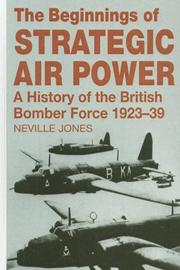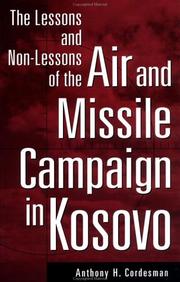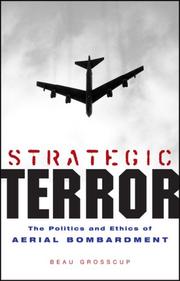| Listing 1 - 10 of 29 | << page >> |
Sort by
|

ISBN: 1935149962 9781935149965 9781935149873 9781932033670 193203367X Year: 2008 Publisher: Drexel Hill, Pa. Newbury [Berkshire, UK] Casemate
Abstract | Keywords | Export | Availability | Bookmark
 Loading...
Loading...Choose an application
- Reference Manager
- EndNote
- RefWorks (Direct export to RefWorks)
This book provides a comprehensive look at air war over Europe during the climactic year of World War II, combining firsthand experience with expert analysis. The centerpiece is a mission-by-mission diary of 1st Lieutenant Richard R. Ayesh, bombardier on a B-17 Flying Fortress, who flew with the 100th Bombardment Group, 13th Combat Wing of the 8th Air Force-the legendary "Bloody 100th." He received the Distinguished Flying Cross, Croix de Guerre and the Air Medal with Four Oak Leaf Clusters, amongst others.This book follows Ayesh's progress from his youth during the Great Depression in Wichita
World War, 1939-1945 --- Bombing, Aerial --- Aerial bombing --- Air strikes --- Airstrikes --- Air warfare --- Bombardment --- Bombers --- Aerial operations, American. --- History --- Ayesh, Richard R. --- Ayesh, Dick
Book
ISBN: 9780813176796 0813176794 9780813176802 0813176808 9780813176819 0813176816 9780813176789 0813176786 Year: 2019 Publisher: Lexington, Kentucky
Abstract | Keywords | Export | Availability | Bookmark
 Loading...
Loading...Choose an application
- Reference Manager
- EndNote
- RefWorks (Direct export to RefWorks)
In the 1930s the US Air Corps Tactical School (ACTS) articulated the concept of high-altitude daylight precision bombing (HADPB), a coherent yet controversial theory for victory through the independent employment of air forces. The ACTS lectures present a uniquely American theory of strategic bombing later tested in World War II. These lectures, never before published, introduce Air Corps thinking on strategic bombing during the interwar period. Their originality is found in the causal logic for how HADPB operations would lead to victory by the direct attack of vital and vulnerable economic targets.
Bombing, Aerial. --- Tactics. --- World War, 1939-1945 --- Military tactics --- Military art and science --- Aerial bombing --- Air strikes --- Airstrikes --- Air warfare --- Bombardment --- Bombers --- Aerial operations, American.

ISBN: 9781136285967 1136285962 1136285962 0203043537 1283840456 9780203043530 9781136286032 9781136286100 9780714633077 9780714683225 1136286039 9781283840453 Year: 1987 Publisher: London, England : Totowa, N.J. : F. Cass ; Biblio Distribution Centre [distributor],
Abstract | Keywords | Export | Availability | Bookmark
 Loading...
Loading...Choose an application
- Reference Manager
- EndNote
- RefWorks (Direct export to RefWorks)
Using official records, the author traces the origins and early development of strategic bombing, and examines its organs in the operations and staff planning of the First World War. The experiences of the First World War should have been a valuable legacy to those who devised the 'counter offensive' strategy in the years between the war. Unfortunately the lessons learnt were soon forgotten and many of the operational and technical problems which the planners had begun to tackle in 1918 were not even seen to exist by the Air Staff during the 1920s and early 1930s.
Strategic forces --- Bombers --- Bombing, Aerial --- Aerial bombing --- Air strikes --- Airstrikes --- Air warfare --- Bombardment --- Airplanes, Military --- Attack planes --- Armed Forces --- Deterrence (Strategy) --- Strategy --- History. --- Great Britain. --- RAF (Royal Air Force) --- R.A.F. --- Royal Air Force (Great Britain)

ISBN: 0313048746 9780313048746 0275972305 9780275972301 0313073929 9780313073922 Year: 2001 Publisher: Westport, Conn. Praeger
Abstract | Keywords | Export | Availability | Bookmark
 Loading...
Loading...Choose an application
- Reference Manager
- EndNote
- RefWorks (Direct export to RefWorks)
Bombing, Aerial --- Kosovo War, 1998-1999 --- Kosovo Conflict, 1998-1999 --- Kosovo Crisis, 1998-1999 --- Aerial bombing --- Air strikes --- Airstrikes --- Air warfare --- Bombardment --- Bombers --- Aerial operations. --- North Atlantic Treaty Organization --- North Atlantic treaty organisation --- NAVO --- OTAN
Book
ISBN: 1139891790 1107289866 1107289300 1139805673 110729035X 1107291402 1107294193 110729312X 1107037948 1299841937 9781461939870 1461939879 9781139805674 9781107290358 9781107037946 9781107291409 Year: 2013 Publisher: Cambridge Cambridge University Press
Abstract | Keywords | Export | Availability | Bookmark
 Loading...
Loading...Choose an application
- Reference Manager
- EndNote
- RefWorks (Direct export to RefWorks)
Giulio Douhet is generally considered the world's most important air-power theorist and this book offers the first comprehensive account of his air-power concepts. It ranges from 1884 when an air service was first implemented within the Italian military to the outbreak of the Second World War, and explores the evolution and dissemination of Douhet's ideas in an international context. It examines the impact of the Libyan war, the First World War and Ethiopian war on the development of Italian air-power strategy. It also addresses the issue of Douhet's advocacy of strategic bombing, exploring why it was that Douhet became an advocate of city bombing; the meaning and the limits of his core concept of 'command of the air'; and the mutual impact of air power, military and naval thought. It also takes into account alternatives to Douhetism such as the theories developed by Amedeo Mecozzi and others.
Air power --- Bombing, Aerial --- Generals --- Aerial bombing --- Air strikes --- Airstrikes --- Air warfare --- Bombardment --- Bombers --- Air superiority --- Military power --- Aeronautics, Military --- Military readiness --- History --- Douhet, Giulio, --- Douhet, G. --- Italy. --- Arts and Humanities
Book
ISBN: 9783518420355 3518420356 Year: 2008 Publisher: Frankfurt am Main Suhrkamp
Abstract | Keywords | Export | Availability | Bookmark
 Loading...
Loading...Choose an application
- Reference Manager
- EndNote
- RefWorks (Direct export to RefWorks)
World War, 1939-1945 --- Bombing, Aerial --- Aerial bombing --- Air strikes --- Airstrikes --- Air warfare --- Bombardment --- Bombers --- European War, 1939-1945 --- Second World War, 1939-1945 --- World War 2, 1939-1945 --- World War II, 1939-1945 --- World War Two, 1939-1945 --- WW II (World War, 1939-1945) --- WWII (World War, 1939-1945) --- History, Modern --- World War (1939-1945) --- Halberstadt (Germany) --- History.
Book
ISBN: 1911534491 1911534483 9781911534495 9781911534501 1911534505 9781911534518 1911534513 Year: 2019 Publisher: London : University of Westminster Press,
Abstract | Keywords | Export | Availability | Bookmark
 Loading...
Loading...Choose an application
- Reference Manager
- EndNote
- RefWorks (Direct export to RefWorks)
The Blitz Companion offers a unique overview of a century of aerial warfare, its impact on cities and the people who lived in them. It tells the story of aerial warfare from the earliest bombing raids and in World War 1 through to the London Blitz and Allied bombings of Europe and Japan. These are compared with more recent American air campaigns over Cambodia and Vietnam in the 1960s and 1970s, the NATO bombings during the Balkan Wars of the 1990s and subsequent bombings in the aftermath of 9/11. Beginning with the premonitions and predictions of air warfare and its terrible consequences, the book focuses on air raids precautions, evacuation and preparations for total war, and resilience, both of citizens and of cities. The legacies of air raids, from reconstruction to commemoration, are also discussed. While a key theme of the book is the futility of many air campaigns, care is taken to situate them in their historical context. The Blitz Companion also includes a guide to documentary and visual resources for students and general readers. Uniquely accessible, comparative and broad in scope this book draws key conclusions about civilian experience in the twentieth century and what these might mean for military engagement and civil reconstruction processes once conflicts have been resolved.
Memorials, monuments --- History --- Military history --- Disability: social aspects --- Air forces & warfare --- Civil defence --- Bombing, Aerial --- Air warfare --- Civilians in war --- Urban warfare --- War --- War and society --- Aerial bombing --- Air strikes --- Airstrikes --- Bombardment --- Bombers --- City warfare --- Warfare, City --- Warfare, Urban --- Military art and science
Book
ISBN: 1400814146 1282087258 9786612087257 1400824974 9781400824977 9781400814145 Year: 2009 Publisher: Princeton, NJ
Abstract | Keywords | Export | Availability | Bookmark
 Loading...
Loading...Choose an application
- Reference Manager
- EndNote
- RefWorks (Direct export to RefWorks)
A major revision of our understanding of long-range bombing, this book examines how Anglo-American ideas about "strategic" bombing were formed and implemented. It argues that ideas about bombing civilian targets rested on--and gained validity from--widespread but substantially erroneous assumptions about the nature of modern industrial societies and their vulnerability to aerial bombardment. These assumptions were derived from the social and political context of the day and were maintained largely through cognitive error and bias. Tami Davis Biddle explains how air theorists, and those influenced by them, came to believe that strategic bombing would be an especially effective coercive tool and how they responded when their assumptions were challenged. Biddle analyzes how a particular interpretation of the World War I experience, together with airmen's organizational interests, shaped interwar debates about strategic bombing and preserved conceptions of its potentially revolutionary character. This flawed interpretation as well as a failure to anticipate implementation problems were revealed as World War II commenced. By then, the British and Americans had invested heavily in strategic bombing. They saw little choice but to try to solve the problems in real time and make long-range bombing as effective as possible. Combining narrative with analysis, this book presents the first-ever comparative history of British and American strategic bombing from its origins through 1945. In examining the ideas and rhetoric on which strategic bombing depended, it offers critical insights into the validity and robustness of those ideas--not only as they applied to World War II but as they apply to contemporary warfare.
Strategic bombers --- Bombing, Aerial --- Aerial bombing --- Air strikes --- Airstrikes --- Air warfare --- Bombardment --- Bombers --- Long-range bombers --- Strategic weapons systems --- Air power --- World War, 1914-1918 --- World War, 1939-1945 --- History. --- Aerial operations, American. --- Aerial operations, British. --- Air superiority --- Military power --- Aeronautics, Military --- Military readiness

ISBN: 1848137842 1281215724 9786611215729 1848130848 9781848130845 9781281215727 1842775421 184277543X 9832535832 9781842775424 9781842775431 9789832535836 135022281X Year: 2006 Publisher: London, England : [London, England] : Zed Books, Bloomsbury Publishing,
Abstract | Keywords | Export | Availability | Bookmark
 Loading...
Loading...Choose an application
- Reference Manager
- EndNote
- RefWorks (Direct export to RefWorks)
Strategic bombardments, either aimed explicitly at civilians or deployed in circumstances where extensive civilian deaths are written off as collateral damage or accidental, are becoming increasingly common. This book shows how certain European colonial powers, notably Britain, initiated aerial bombardment of civilians after World War I, how it was an instrument of choice in World War II, and how it has since been refined and practised by the US in Korea, Vietnam, the Balkans, Afghanistan and Iraq. It exposes the rationalizations put forward to avoid the label of?state terrorism?, the race, g.
Terrorism. --- Bombing, Aerial. --- Air warfare --- Aerial strategy --- Aerial tactics --- Aerial warfare --- Air strategy --- Air tactics --- Aeronautics, Military --- War --- Air power --- Airplanes, Military --- Aerial bombing --- Air strikes --- Airstrikes --- Bombardment --- Bombers --- Acts of terrorism --- Attacks, Terrorist --- Global terrorism --- International terrorism --- Political terrorism --- Terror attacks --- Terrorist acts --- Terrorist attacks --- World terrorism --- Direct action --- Insurgency --- Political crimes and offenses --- Subversive activities --- Political violence --- Terror --- Psychological aspects. --- Military tactics
Book
ISBN: 0191645567 9780191645563 9780199668519 0199668515 1306188660 9781306188661 0191645575 Year: 2014 Publisher: New York Oxford University Press
Abstract | Keywords | Export | Availability | Bookmark
 Loading...
Loading...Choose an application
- Reference Manager
- EndNote
- RefWorks (Direct export to RefWorks)
The German 'Blitz' that followed the Battle of Britain killed tens of thousands and laid waste to large areas of many British cities. And although the destruction of 1940-1 was never repeated on the same scale, fears that Hitler possessed a secret weapon of mass destruction never entirely died, and were partially realized in the VI and V2 raids of 1944-5. The British and American response to the 'Blitz', especially from 1943 onwards, was massive and incomparably more devastating - withapocalyptic consequences for German cities such as Hamburg, Dresden, and Berlin, to name but the most prominen
World War, 1939-1945 --- Bombing, Aerial --- Aerial bombing --- Air strikes --- Airstrikes --- Air warfare --- Bombardment --- Bombers --- Aerial operations, American. --- Aerial operations, British. --- Aerial operations, German. --- History --- 2ème guerre mondiale --- Bombardement aérien --- Aerial operations, American --- Aerial operations, British --- Aerial operations, German --- Opérations aériennes américaines --- Opérations aériennes britanniques --- Opérations aériennes allemandes --- Histoire
| Listing 1 - 10 of 29 | << page >> |
Sort by
|

 Search
Search Feedback
Feedback About UniCat
About UniCat  Help
Help News
News